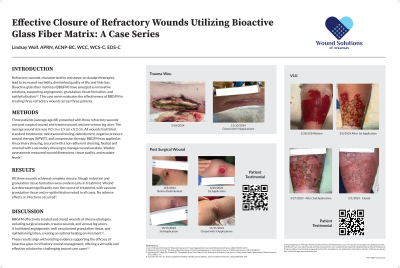Case Series/Study
(CS-172) Effective Closure of Refractory Wounds Utilizing Bioactive Glass Fiber Matrix: A Case Series

Refractory wounds, characterized by resistance to standard therapies, lead to increased morbidity, diminished quality of life, and limb loss. Bioactive glass fiber matrices have emerged as innovative solutions, promoting angiogenesis, granulation tissue formation, and epithelialization【1】【2】. This case series evaluates the effectiveness of bioactive glass fiber matrix in treating five refractory wounds across three patients.
Methods:
Three patients (average age 68) presented with five refractory wounds: two pressure injuries, one post-surgical wound, one trauma wound, and one venous leg ulcer. The average wound size was 9.0 cm × 2.5 cm × 0.2 cm. All wounds had failed standard treatments, moist wound healing, debridement, negative pressure wound therapy (NPWT), and compression therapy. Bioactive glass fiber matrix was applied as the primary dressing, secured with a non-adherent dressing, fixated and covered with a secondary dressing to manage wound exudate. Weekly assessments measured wound dimensions, tissue quality, and exudate levels【3】.
Results:
All five wounds achieved complete closure. Slough reduction and granulation tissue formation were evident early in treatment. Wound size decreased significantly over the course of treatment, with vascular granulation tissue and re-epithelization noted in all cases. No adverse effects or infections occurred【4】.
Discussion:
Bioactive glass fiber matrix effectively treated and closed wounds of diverse etiologies, including pressure injuries, surgical wounds, trauma wounds, and venous leg ulcers. Its bioactive properties facilitated angiogenesis, collagen deposition, and epithelial migration, creating an optimal healing environment【1】【5】. These results align with existing evidence supporting the efficacy of bioactive glass in refractory wound management, offering a versatile and effective solution for challenging wound care cases【2】【4】.

.jpg)